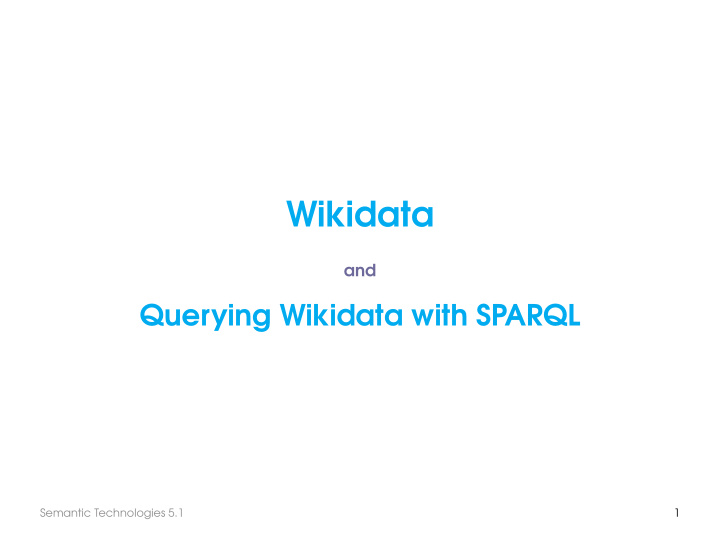



Wikidata and Querying Wikidata with SPARQL Semantic Technologies 5.1 1
What are the ten largest cities with a female mayor? Semantic Technologies 5.1 2
Where are people born who travel to space? (colour-coded by gender) Semantic Technologies 5.1 3
Which days of the week do disasters occur? Semantic Technologies 5.1 4
Which 19th century paintings show the moon? Semantic Technologies 5.1 5
Which films co-star more than one future head of government? Semantic Technologies 5.1 6
A Free Knowledge Graph Wikidata Wikipedia’s knowledge graph • Free, community-built database • Large graph • (October 2018: > 570M statements on > 50M entities) Large, active community • (October 2018: > 230,000 logged-in human editors) Many applications • Freely available, relevant, and active knowledge graph Semantic Technologies 5.1 7
A short history of Wikidata August 2005: Presentation “Wikipedia and the Semantic Web—The Missing • Links” at the 1st Wikimedia Conference “Wikimania”, Frankfurt, Germany 29th October 2012: wikidata.org is launched • 15th Dec 2012: Item with ID number 1000000 created • 4th Feb 2013: The first statements can be created • Early 2013: Most Wikipedia language links relocate to Wikidata • Late 2013: More than 100,000,000 edits on over 15M items • Dec 2014: Google announces the closure of Freebase and migration to • Wikidata 2014–2018: A total of > 700M edits produce > 55M items and > 570M • statements May 2018: Wikidata starts storing data about lexemes • (= expressions in a language) Oct 2018: Senses of lexemes become supported • Semantic Technologies 5.1 8
Many applications (1) As of today, Wikidata content has been used in many ways. Wikipedia & the Wikimedia community: Wikipedia inter-language links (see any Wikipedia page) • Data displays in pages (auto-generated info boxes, article placeholders, • result tables, . . . ) Quality checks & edit-a-thons • External re-uses of data: Application-specific data-excerpts (e.g., Eurowings in-flight app) • Data integration and quality control • (e.g., Google checks own KG against Wikidata) Authority control & identity provider (VIAF , Open Streetmaps, DBLP , . . . link • their content to Wikidata) Data-driven journalism (individual analyses as well as data-driven • information portals) Semantic Technologies 5.1 9
Many applications (2) As of today, Wikidata content has been used in many ways. In research: Test data for KG-related algorithms • Training data for machine-learning approaches • Wikidata as a subject of study (social dynamics, internationality, biases, . . . ) • Uses by Wikidata community: Software-supported error and vandalism detection • Feature-based integration with other datasets • Data-driven statistics as a measure of progress • Semantic Technologies 5.1 10
What is Wikidata? Wikidata is often described as “the free knowledge base that anyone can edit” or the “knowledge graph of Wikipedia” It is useful to distinguish several of these aspects: Wikidata is . . . . . . a Wikimedia project like Wikipedia and Wikimedia Commons; • represented and supported by the Wikimedia Foundation (WMF) . . . a dataset that can be downloaded and freely used and distributed • . . . a website through which the data can be viewed and modified • . . . a community of volunteer editors that creates and controls all content • Semantic Technologies 5.1 11
Two views on the Wikidata knowledge base The website and its main data services Conceptually and for most applica- expose Wikidata as a document- tions, Wikidata is a graph-structured centric knowledge base: knowledge base: Main content are binary relation- Data is grouped by subject entity • • ships (from entities to entities/data (one page per entity) values) Documents are structured into dif- • Properties are first-class objects ferent sections • with a global scope and definition The order of content is (mostly) pre- • Order does not affect the meaning served and shown • of statements � Useful for display & management � Useful for sharing and re-use We will mostly view Wikidata as a knowledge graph Semantic Technologies 5.1 12
Wikidata https://www.wikidata.org/wiki/Q80 https://towardsdatascience.com/a-brief-introduction-to-wikidata-bb4e66395eb1 Querying Wikidata with SPARQL for Absolute Beginners https://www.youtube.com/watch?v=kJph4q0Im98 https://www.wikidata.org/wiki/Wikidata:SPARQL_tutorial Wikidata Query Service https://query.wikidata.org Semantic Technologies 5.1 13
Recommend
More recommend